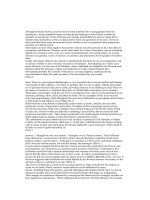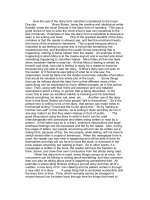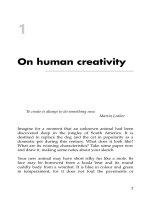how the bug wars changed the art of origami
Bạn đang xem bản rút gọn của tài liệu. Xem và tải ngay bản đầy đủ của tài liệu tại đây (27.96 MB, 186 trang )
Job:06-30780 Title: Origami Masters Bugs
#175 DTP:228 Page:1
(RAY)
001-184_30780.indd 1 6/25/13 2:54 PM
Job:06-30780 Title: Origami Masters Bugs
#175 DTP:228 Page:1
(RAY)
001-184_30780.indd 1 6/25/13 3:56 PM
Job:06-30780 Title: Origami Masters Bugs
#175 DTP:228 Page:2
Job:06-30780 Title: Origami Masters Bugs
#175 DTP:228 Page:3
(RAY)
001-184_30780.indd 3
6/25/13 2:54 PM
HOW THE BUG WARS CHANGED
THE ART OF ORIGAMI
With bug models created by:
SEBASTIAN ARELLANO
SHUKI KATO
MARC KIRSCHENBAUM
JASON KU
ROBERT J. LANG
WON PARK
DAN ROBINSON
Introduction by Sherry Gerstein
Illustrations by Marcio Noguchi
Job:06-30780 Title: Origami Masters Bugs
#175 DTP:228 Page:2
Job:06-30780 Title: Origami Masters Bugs
#175 DTP:228 Page:3
(RAY)
001-184_30780.indd 3 6/25/13 3:56 PM
Job:06-30780 Title: Origami Masters Bugs
#175 DTP:228 Page:4
Job:06-30780 Title: Origami Masters Bugs
#175 DTP:228 Page:5
(RAY)
001-184_30780.indd 5
6/25/13 2:54 PM
e artist is a receptacle for emotions that come
from all over the place: from the sky, from the
earth, from a scrap of paper . . .
–Pablo Picasso
(Text)
Job:06-30780 Title: Origami Masters Bugs
#175 DTP:228 Page:4
Job:06-30780 Title: Origami Masters Bugs
#175 DTP:228 Page:5
(RAY)
001-184_30780.indd 5 6/25/13 3:56 PM
Job:06-30780 Title: Origami Masters Bugs
#175 DTP:228 Page:6
(RAY)
001-184_30780.indd 6
6/25/13 3:48 PM
(Text)
Introduction 8
Terms and Symbols 14
The Projects 17
Won Park 18
Flapping Dollar Butterfly 19
Dollar Dragonfly 23
Sebastian Arellano 28
Bed Bug 29
Praying Mantis 36
Marc Kirschenbaum 46
Mosquito 47
Ladybug 55
CONTENTS
Job:06-30780 Title: Origami Masters Bugs
#175 DTP:228 Page:6
(RAY)
001-184_30780.indd 6 6/25/13 3:56 PM
Job:06-30780 Title: Origami Masters Bugs
#175 DTP:228 Page:6
Job:06-30780 Title: Origami Masters Bugs
#175 DTP:228 Page:7
(RAY)
001-184_30780.indd 7
6/25/13 3:48 PM
(Text)
Daniel Robinson 70
Leaf Insect 71
Jason Ku 82
Rhinoceros Beetle 83
Luna Moth 99
Shuki Kato 122
Titan Beetle 123
Flying Hercules Beetle 141
Robert J. Lang 162
Yellow Jacket, Opus 624 163
The Crease Patterns 176
About the Illustrator 183
Credits and Acknowledgements . . 184
Job:06-30780 Title: Origami Masters Bugs
#175 DTP:228 Page:6
Job:06-30780 Title: Origami Masters Bugs
#175 DTP:228 Page:7
(RAY)
001-184_30780.indd 7 6/25/13 3:56 PM
25
12
13
18
20
3444
60
64
72
77
79 80
85
102 103
104
118
119
120
121
122
134
135
136
137 139
1
1.9214+12%
2
1.5000+12%
3
1.5000+12%
4
0.3000+21%
5
1.0000+10%
6
1.0000+10%
7
0.6000-20%
8
0.7500+20%
9
0.7500+20%
10
0.6000-4%
11
1.0000+8%
12
1.0000+8%
13
0.6000+20%
14
0.6000+31%
1
2
34
5
67
8
910
11
1213 14
15
1
paired
2
paired
3
paired
4
paired
5
pos-xy
6
pos-xy
7
pos-s
8
active
9
active+f
10
pos-e
11
pos-e
12
pos-e
13
pos-e
14
active
15
active
16
active
17
active+f
18
same
19
same
20
same
21
same
22
active+f
23
active
24
active
25
active+f
26
same
cockroach.tmd5 scale = 0.1385
Job:06-30780 Title: Origami Masters Bugs
#175 DTP:228 Page:8
(RAY)
001-184_30780.indd 8
6/25/13 3:13 PM
8 Origami Masters: Bugs
(Text)
THe Bug WARS
What can you make with a single piece of paper?
Scissors can’t be used, nor can glue. It’s just you, the piece of paper, and the shapes you
make by folding it. So how far can you take it?
is was essentially the question posed by the informal competition between expert
paper folders in the 1990s. at competition, which has come to be known as “e Bug
Wars,” was an expression of the discovery process and an exploration of technique by
the most experienced folders, once they found themselves liberated from the traditional
underpinnings of the ancient art of origami. e discovery that it was possible to create a
model with several legs—like an insect, for instance—quite simply transformed origami.
Until the middle of the 20th century,
all origami models were derived from
just a few standard base patterns.
Job:06-30780 Title: Origami Masters Bugs
#175 DTP:228 Page:8
(RAY)
001-184_30780.indd 8 6/25/13 3:56 PM
25
12
13
18
20
3444
60
64
72
77
79 80
85
102 103
104
118
119
120
121
122
134
135
136
137 139
1
1.9214+12%
2
1.5000+12%
3
1.5000+12%
4
0.3000+21%
5
1.0000+10%
6
1.0000+10%
7
0.6000-20%
8
0.7500+20%
9
0.7500+20%
10
0.6000-4%
11
1.0000+8%
12
1.0000+8%
13
0.6000+20%
14
0.6000+31%
1
2
34
5
67
8
910
11
1213 14
15
1
paired
2
paired
3
paired
4
paired
5
pos-xy
6
pos-xy
7
pos-s
8
active
9
active+f
10
pos-e
11
pos-e
12
pos-e
13
pos-e
14
active
15
active
16
active
17
active+f
18
same
19
same
20
same
21
same
22
active+f
23
active
24
active
25
active+f
26
same
cockroach.tmd5 scale = 0.1385
Job:06-30780 Title: Origami Masters Bugs
#175 DTP:228 Page:8
Job:06-30780 Title: Origami Masters Bugs
#175 DTP:228 Page:9
(RAY)
001-184_30780.indd 9
6/25/13 3:13 PM
(Text)
It sounds like a crazy notion because these days, complex origami
models—intricately folded paper interpretations of just about everything,
from spine-studded sea urchins to a complete cuckoo clock—abound.
Even though origami is an ancient art, it remained pretty much
unchanged until the middle of the 20th century. Models were fairly
simple, and all were derived from a few standard base patterns.
at began to change when Japan’s Akira Yoshizawa developed a system of diagrams and
symbols that allowed for the encoding of origami instructions. Considered the father of
modern origami and a prolic creator of new, original models, Yoshizawa wrote books in
the 1940s and 1950s that showed how to fold each step. Suddenly, a cra that had been an
oral tradition shared by a few could be documented…and shared by many.
Akira Yoshizawa,
called by many
the father of
modern origami
Introduction 9
Job:06-30780 Title: Origami Masters Bugs
#175 DTP:228 Page:8
Job:06-30780 Title: Origami Masters Bugs
#175 DTP:228 Page:9
(RAY)
001-184_30780.indd 9 6/25/13 3:56 PM
25
12
13
18
20
3444
60
64
72
77
79 80
85
102 103
104
118
119
120
121
122
134
135
136
137 139
1
1.9214+12%
2
1.5000+12%
3
1.5000+12%
4
0.3000+21%
5
1.0000+10%
6
1.0000+10%
7
0.6000-20%
8
0.7500+20%
9
0.7500+20%
10
0.6000-4%
11
1.0000+8%
12
1.0000+8%
13
0.6000+20%
14
0.6000+31%
1
2
34
5
67
8
910
11
1213 14
15
1
paired
2
paired
3
paired
4
paired
5
pos-xy
6
pos-xy
7
pos-s
8
active
9
active+f
10
pos-e
11
pos-e
12
pos-e
13
pos-e
14
active
15
active
16
active
17
active+f
18
same
19
same
20
same
21
same
22
active+f
23
active
24
active
25
active+f
26
same
cockroach.tmd5 scale = 0.1385
Job:06-30780 Title: Origami Masters Bugs
#175 DTP:228 Page:10
(RAY)
001-184_30780.indd 10
6/25/13 3:13 PM
Yoshizawa’s system of symbols was
adopted and rened by Samuel Randlett
in the US and Robert Harbin in the UK,
and word of the art of paper folding
began to spread. Some European
countries also had traditional paper
folding cras and those were shared
as well. It was this cross-fertilization
process that brought fresh thinkers and
ideas to the ancient art, building a new
mindset that would eventually look past
the traditional forms.
By the 1970s and 1980s, things reached
critical mass. Origami societies had
sprung up all over—in Japan, the
US, the UK, and Spain, to name a few. While origami still focused on the classical
models and techniques of Japan, new models were being created and shared by folders
everywhere. e origami community is nothing if not generous with its knowledge. But
the models were still fairly simple, around 30 or so steps at the most. And no one could
gure out how to use the traditional origami bases to make the additional aps that
would allow them to take the art to the next level.
Aer initial breakthroughs and innovations made by John Montroll in the US and
Jun Maekawa in Japan, another breakthrough was made: a technique called circle/
river packing. Developed by American folder Robert J. Lang (an origami enthusiast
with a scientic background) and Japanese folder Toshiyuki Meguro—each working
independently—the work was published in the 1990s. is technique allowed a model
creator to place any number of circles—which stood in for appendages—within a
square of paper. It was a brilliant bit of engineering that resulted in the placement of
folds in order to create multiple legs, wings, and other appendages right where they
were needed. It also showed origami enthusiasts that they didn’t need to be tied down
by traditional techniques. Instead, those traditional techniques were now the rst
important steps toward a new level of art and cra.
Diagrams from an origami book by Samuel Randlett
10 Origami Masters: Bugs
(Text)
Job:06-30780 Title: Origami Masters Bugs
#175 DTP:228 Page:10
(RAY)
001-184_30780.indd 10 6/25/13 3:56 PM
25
12
13
18
20
3444
60
64
72
77
79 80
85
102 103
104
118
119
120
121
122
134
135
136
137 139
1
1.9214+12%
2
1.5000+12%
3
1.5000+12%
4
0.3000+21%
5
1.0000+10%
6
1.0000+10%
7
0.6000-20%
8
0.7500+20%
9
0.7500+20%
10
0.6000-4%
11
1.0000+8%
12
1.0000+8%
13
0.6000+20%
14
0.6000+31%
1
2
34
5
67
8
910
11
1213 14
15
1
paired
2
paired
3
paired
4
paired
5
pos-xy
6
pos-xy
7
pos-s
8
active
9
active+f
10
pos-e
11
pos-e
12
pos-e
13
pos-e
14
active
15
active
16
active
17
active+f
18
same
19
same
20
same
21
same
22
active+f
23
active
24
active
25
active+f
26
same
cockroach.tmd5 scale = 0.1385
25
12
13
18
20
3444
60
64
72
77
79 80
85
102 103
104
118
119
120
121
122
134
135
136
137 139
1
1.9214+12%
2
1.5000+12%
3
1.5000+12%
4
0.3000+21%
5
1.0000+10%
6
1.0000+10%
7
0.6000-20%
8
0.7500+20%
9
0.7500+20%
10
0.6000-4%
11
1.0000+8%
12
1.0000+8%
13
0.6000+20%
14
0.6000+31%
1
2
34
5
67
8
910
11
1213 14
15
1
paired
2
paired
3
paired
4
paired
5
pos-xy
6
pos-xy
7
pos-s
8
active
9
active+f
10
pos-e
11
pos-e
12
pos-e
13
pos-e
14
active
15
active
16
active
17
active+f
18
same
19
same
20
same
21
same
22
active+f
23
active
24
active
25
active+f
26
same
cock
roach.
tmd5 scale = 0.
1385
Job:06-30780 Title: Origami Masters Bugs
#175 DTP:228 Page:10
Job:06-30780 Title: Origami Masters Bugs
#175 DTP:228 Page:11
(RAY)
001-184_30780.indd 11 6/25/13 3:13 PM
a. Generic crease pattern; b. Crease pattern generated by TreeMaker; c. Base; d. Folded model
Another technical innovation helped demonstrate that even the most complex of
models could be tackled, designed, and communicated in a systematic way: it was
the invention of TreeMaker, a computer program written by Robert J. Lang. It would
eventually allow the computational modeling of a stick gure—a rough idea of what
a model should look like—to generate a basic outline for the crease pattern needed to
create the model. Origami artists began to use the same concepts in their own designs,
not even needing the computer program; they could create incredibly complex gures
using just pencil and paper to design a “crease pattern” as the folding plan for their
work. Crease patterns became the standard way to communicate instructions for
supercomplex models, because such models cannot always be broken down into step-
by-step diagrams.
b.
a.
c.
d.
Introduction 11
(Text)
Job:06-30780 Title: Origami Masters Bugs
#175 DTP:228 Page:10
Job:06-30780 Title: Origami Masters Bugs
#175 DTP:228 Page:11
(RAY)
001-184_30780.indd 11
6/25/13 3:56 PM
25
12
13
18
20
3444
60
64
72
77
79 80
85
102 103
104
1
1.9214+12%
2
1.5000+12%
3
1.5000+12%
4
0.3000+21%
5
1.0000+10%
6
1.0000+10%
7
0.6000-20%
8
0.7500+20%
9
0.7500+20%
10
0.6000-4%
11
1.0000+8%
12
1.0000+8%
13
0.6000+20%
14
0.6000+31%
1
2
34
5
67
8
910
11
1213 14
15
1
paired
2
paired
3
paired
4
paired
5
pos-xy
6
pos-xy
7
pos-s
8
active
9
active+f
10
pos-e
11
pos-e
12
pos-e
13
pos-e
14
active
15
active
16
active
17
active+f
18
same
19
same
20
same
21
same
22
active+f
23
active
24
active
25
active+f
26
same
cockroach.tmd5 scale = 0.1385
Job:06-30780 Title: Origami Masters Bugs
#175 DTP:228 Page:12
(RAY)
001-184_30780.indd 12
6/25/13 3:14 PM
(Text)
Such an innovation allows model creators to spend less time testing ideas out—a process
that becomes quite burdensome with long, super-complex models—and more time
working out a greater number of new ideas, as long as the creators are comfortable with
the geometric method of design. It can shorten the development time greatly.
Expert folders in Japan were the rst to stretch their new wings (as it were) by folding
realistic insects. Each year at the annual meeting of the Japanese Origami Academic
Society, artists such as Toshiyuki Meguro, Jun Maekawa, Seiji Nishikawa, and Fumiaki
Kawahata would show o their latest and greatest feats of folding (all done without
computational modeling), which would then set the bar for the following year’s models.
First, there were insects with six legs, then came the addition of wings, horns, color
changes indicating spots, and more. From there, the spirit of friendly competition made
its way to America at the annual OrigamiUSA convention. Robert J. Lang, the only
American to be involved in the informal Japanese competition, challenged friends Dan
Robinson and Satoshi Kamiya to come up with a design for a Eupatorus gracilcornis, a
ve-horned rhinoceros beetle. And on it went.
e models collected in this book aren’t from that 2004 design challenge. But that
spirit of competitive collaboration does live on in the models presented here. ey
showcase the latest technical innovations from some of the top folders on this side of
the Atlantic. ey are, in essence, the culmination of more than 20 years of technical
experimentation.
But they also mark the end of an era. Now that the technical barriers have been broken
down, origami stands at a crossroads. Is it art, mathematics, science…or a bit of all
three? Many creators of origami models have moved on. ey’ve turned their focus on
the search for beauty and art in simplicity instead of in the technically accomplished.
Try googling “polygon packing” (a concept similar to circle/river packing) and you’ll
nd websites devoted to discussions on engineering. And industrial designers continue
to tap into the origami community to nd ways to use folding in new inventions. One
good possibility: a new way to fold airbags.
So what’s next for origami? A good question. Its artists are already turning the paper
over, folding again, and seeing what can be made this time.
12 Origami Masters: Bugs
Job:06-30780 Title: Origami Masters Bugs
#175 DTP:228 Page:12
(RAY)
001-184_30780.indd 12 6/25/13 3:56 PM
25
12
13
18
20
3444
60
64
72
77
79 80
85
102 103
104
1
1.9214+12%
2
1.5000+12%
3
1.5000+12%
4
0.3000+21%
5
1.0000+10%
6
1.0000+10%
7
0.6000-20%
8
0.7500+20%
9
0.7500+20%
10
0.6000-4%
11
1.0000+8%
12
1.0000+8%
13
0.6000+20%
14
0.6000+31%
1
2
34
5
67
8
910
11
1213 14
15
1
paired
2
paired
3
paired
4
paired
5
pos-xy
6
pos-xy
7
pos-s
8
active
9
active+f
10
pos-e
11
pos-e
12
pos-e
13
pos-e
14
active
15
active
16
active
17
active+f
18
same
19
same
20
same
21
same
22
active+f
23
active
24
active
25
active+f
26
same
cockroach.tmd5 scale = 0.1385
Job:06-30780 Title: Origami Masters Bugs
#175 DTP:228 Page:12
Job:06-30780 Title: Origami Masters Bugs
#175 DTP:228 Page:13
(RAY)
001-184_30780.indd 13
6/25/13 3:14 PM
(Text)
We can allow satellites, planets, suns, universe,
nay whole systems of universes, to be governed
by laws, but the smallest insect, we wish to be
created at once by special act.
–Charles Darwin
Job:06-30780 Title: Origami Masters Bugs
#175 DTP:228 Page:12
Job:06-30780 Title: Origami Masters Bugs
#175 DTP:228 Page:13
(RAY)
001-184_30780.indd 13 6/25/13 3:56 PM
Edge
Existing Crease
Valley fold
Mountain fold
Fold in front
Fold behind
Fold and unfold
Hidden lines
Rotate
Sink / Squash / Push
View from here
Turn over
Open
Repeat
Magnify
Magnifying glass
Pleat
Symbols
Edge
Existing Crease
Valley fold
Mountain fold
Fold in front
Fold behind
Fold and unfold
Hidden lines
Rotate
Sink / Squash / Push
View from here
Turn over
Open
Repeat
Magnify
Magnifying glass
Pleat
Symbols
Edge
Existing Crease
Valley fold
Mountain fold
Fold in front
Fold behind
Fold and unfold
Hidden lines
Rotate
Sink / Squash / Push
View from here
Turn over
Open
Repeat
Magnify
Magnifying glass
Pleat
Symbols
Job:06-30780 Title: Origami Masters Bugs
#175 DTP:228 Page:14
(RAY)
001-184_30780.indd 14 6/25/13 3:14 PM
Edge
Preliminary base
Water-bomb base
Blintz base
Kite base/fold
Petal fold
Existing crease
Valley fold
Mountain fold
Fold in front
Fold behind
Fold and unfold
Hidden lines
Rotate
Sink/squash/push
View from here
Turn over
Open
Repeat
Magnify
View of detail next
Pleat
Crimp
TeRMS & SYMBoLS
14 Origami Masters: Bugs
6–10
(Text)
Job:06-30780 Title: Origami Masters Bugs
#175 DTP:228 Page:14
(RAY)
001-184_30780.indd 14 6/25/13 3:56 PM
Job:06-30780 Title: Origami Masters Bugs
#175 DTP:228 Page:14
Job:06-30780 Title: Origami Masters Bugs
#175 DTP:228 Page:15
(RAY)
001-184_30780.indd 15 6/25/13 3:14 PM
Rabbit ear fold
Inside reverse
fold
Outside reverse
fold
Spread squash
Squash fold
Swivel fold Elias
stretch
Stretch
Crimp
Pleat
Closed
sink
Open sink
Terms & Symbols 15
(Text)
Job:06-30780 Title: Origami Masters Bugs
#175 DTP:228 Page:14
Job:06-30780 Title: Origami Masters Bugs
#175 DTP:228 Page:15
(RAY)
001-184_30780.indd 15 6/25/13 3:56 PM
Job:06-30780 Title: Origami Masters Bugs
#175 DTP:228 Page:16
(RAY)
001-184_30780.indd 16
6/25/13 3:14 PM
(Text)
Job:06-30780 Title: Origami Masters Bugs
#175 DTP:228 Page:16
(RAY)
001-184_30780.indd 16 6/25/13 3:56 PM
Job:06-30780 Title: Origami Masters Bugs
#175 DTP:228 Page:16
Job:06-30780 Title: Origami Masters Bugs
#175 DTP:228 Page:17
(RAY)
001-184_30780.indd 17
6/25/13 3:14 PM
(Text)
THe PRoJecTS
Job:06-30780 Title: Origami Masters Bugs
#175 DTP:228 Page:16
Job:06-30780 Title: Origami Masters Bugs
#175 DTP:228 Page:17
(RAY)
001-184_30780.indd 17 6/25/13 3:56 PM
Job:06-30780 Title: Origami Masters Bugs
#175 DTP:228 Page:18
(RAY)
001-184_30780.indd 18
6/25/13 3:15 PM
18 Origami Masters: Bug Wars
(Text)
Won Park is an origami artist who has
been practicing the art of paper folding
for more than 30 years.
He specializes in folding paper
currency from the United States and
other countries. He is well known for
his meticulous folding execution,
his eye for detail, and a nely
tuned sense of artistry.
He currently lives in Honolulu, Hawaii.
Won PARK
Flapping Dollar
Buttery
Dollar
Dragony
Job:06-30780 Title: Origami Masters Bugs
#175 DTP:228 Page:18
(RAY)
001-184_30780.indd 18 6/25/13 3:56 PM
Job:06-30780 Title: Origami Masters Bugs
#175 DTP:228 Page:18
Job:06-30780 Title: Origami Masters Bugs
#175 DTP:228 Page:19
(RAY)
001-184_30780.indd 19
6/25/13 3:15 PM
(Text)
Fold in half. Unfold
Make another pinch mark
close to the edge. Turn over.
Bring edge to edge and fold
an angle bisector.
Make a pinch mark close to
the edge.
Use the existing crease to
fold in half. Align the creases.
e model will not lie at.
New crease Do not crease
Gently curved
Fold. Unfold.
Fold as indicated. Unfold.
Turn over.
1
4
7
3
6
2
5
is is one of my
latest designs,
created in 2012. I
wanted to create a
model that would
capture the apping
motion of a real
buttery. To make
sure you get a clean
apping action, try
ironing the model
aer it has been
completely folded.
FLAPPIng DoLLAR
BuTTeRFLY
Flapping Dollar Buttery 19
Job:06-30780 Title: Origami Masters Bugs
#175 DTP:228 Page:18
Job:06-30780 Title: Origami Masters Bugs
#175 DTP:228 Page:19
(RAY)
001-184_30780.indd 19 6/25/13 3:56 PM
Job:06-30780 Title: Origami Masters Bugs
#175 DTP:228 Page:20
(RAY)
001-184_30780.indd 20
6/25/13 3:15 PM
(Text)
Unfold everything.Create a new crease to allow the
model to lie completely at.
Pleat, using the creases
created in step 5.
Fold between the points
indicated from edge to
edge. Unfold. Turn over.
Complete the collapse
following a sequence
similar to steps 7 through
9. Use existing creases.
e model should then lie
completely at.
Fold the angle bisectors.
Unfold.
Begin the collapse by
folding the rabbit ear and
in half as indicated. is
should create concave
halves on each side.
Repeat steps 6 to 10 on the
other side.
Fold the edge to the crease
line as indicated. Turn over.
1098
13
16
12
15
11
14
6-10
20 Origami Masters: Bugs
Job:06-30780 Title: Origami Masters Bugs
#175 DTP:228 Page:20
(RAY)
001-184_30780.indd 20 6/25/13 3:56 PM
Job:06-30780 Title: Origami Masters Bugs
#175 DTP:228 Page:20
Job:06-30780 Title: Origami Masters Bugs
#175 DTP:228 Page:21
(RAY)
001-184_30780.indd 21
6/25/13 3:15 PM
(Text)
Valley fold using the creases
created in steps 12 and 13.
Repeat on the other side.
Inside reverse using the
creases created in step 14.
Open the top layer to see
inside the model.
Fold the corner inside as
indicated, while allowing
the wings to ip out. e
model will not lie at.
Swivel fold by releasing
paper trapped under the
layer. Repeat on the back.
Open.
Fold the angle bisectors,
edge to edge. Repeat on
the back.
Close. e model should
like completely at.
Swivel the top to make it at.
Spread squash the bottom
symmetrically. Repeat on
the back. e model will lie
at at this point.
191817
22
25
21
24
20
23
Flapping Dollar Buttery 21
Job:06-30780 Title: Origami Masters Bugs
#175 DTP:228 Page:20
Job:06-30780 Title: Origami Masters Bugs
#175 DTP:228 Page:21
(RAY)
001-184_30780.indd 21 6/25/13 3:56 PM
Job:06-30780 Title: Origami Masters Bugs
#175 DTP:228 Page:22
(RAY)
001-184_30780.indd 22
6/25/13 3:16 PM
(Text)
is is the completed
Flapping Dollar Buttery.
To make the wings sti
enough to ap, iron them.
Valley fold the top layer of
the pleat and squash. Repeat
on the other wing, too.
Details for the wings next.
Hold the head while pulling
on the tail to ap the wings.
Top view of folded model,
wings open.
282726
29
22 Origami Masters: Bugs
Job:06-30780 Title: Origami Masters Bugs
#175 DTP:228 Page:22
(RAY)
001-184_30780.indd 22 6/25/13 3:56 PM
Job:06-30780 Title: Origami Masters Bugs
#175 DTP:228 Page:23
(RAY)
Job:06-30780 Title: Origami Masters Bugs
#175 DTP:228 Page:22
001-184_30780.indd 23 6/25/13 3:17 PM
(Text)
Fold in half. Unfold
Prepare creases for the
collapse.
Inside reverse fold.
Fold. Unfold.
Fold. Unfold.
Fold. Unfold. Turn over.
Complete collapse.
1
4
7
3
6
2
5
DoLLAR
DRAgonFLY
is is one of my very
rst original models.
I created it in high
school. It uses the
same base as my rst
buttery design. My
advice for making a
model with clean folds:
dampen the bill slightly
and use clamps to set
folds properly.
Dollar Dragony 23
Job:06-30780 Title: Origami Masters Bugs
#175 DTP:228 Page:23
(RAY)
Job:06-30780 Title: Origami Masters Bugs
#175 DTP:228 Page:22
001-184_30780.indd 23 6/25/13 3:56 PM
Job:06-30780 Title: Origami Masters Bugs
#175 DTP:228 Page:24
(RAY)
001-184_30780.indd 24
6/25/13 3:17 PM
24 Origami Masters: Bugs
(Text)
Fold as far as you can.
Repeat on the back.
Fold in half. Rotate.Fold as far as you can.
Swivel fold.
Repeat on the back.
Valley fold. Repeat on the
back.
Fold as far as you can.
Repeat on the back.
Swivel fold so that the
horizontal edges are
aligned. Repeat on the back.
Swivel the top layer while
folding the ap back to
the original position.
Repeat on the back.
Swivel fold so that the
horizontal edges are
aligned. Repeat on the back.
1098
13
16
12
15
11
14
Job:06-30780 Title: Origami Masters Bugs
#175 DTP:228 Page:24
(RAY)
001-184_30780.indd 24 6/25/13 3:56 PM
Job:06-30780 Title: Origami Masters Bugs
#175 DTP:228 Page:24
Job:06-30780 Title: Origami Masters Bugs
#175 DTP:228 Page:25
(RAY)
001-184_30780.indd 25 6/25/13 3:17 PM
(Text)
Fold the wing up.
Repeat on the back.
Fold the head aps
between the crimp.
Crimp fold and move
the wing forward.
Repeat on the back.
Fold the wings down.
Fold back the corners to
shape the eyes.
Close the wing at slight
angle. Repeat on the back.
Pleat to form the eyes and
the mouthparts.
Open the wing and
squash symmetrically.
Repeat on the back.
Unfold in half.
191817
22
25
21
24
20
23
Dollar Dragony 25
Job:06-30780 Title: Origami Masters Bugs
#175 DTP:228 Page:24
Job:06-30780 Title: Origami Masters Bugs
#175 DTP:228 Page:25
(RAY)
001-184_30780.indd 25 6/25/13 3:56 PM









